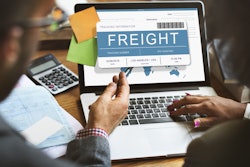 Meeting new visibility requirements of shippers is becoming more difficult with traditional tools like EDI.
Meeting new visibility requirements of shippers is becoming more difficult with traditional tools like EDI.Supply chain professionals are carrying their experiences with business-to-consumer (B2C) e-commerce sites, like Amazon, over to their work lives.
“Everybody is expecting shipments to be like Amazon with complete visibility,” said Ryan Rogers, chief transformation officer of Covenant Transport Services, a Chattanooga, Tenn.-based carrier and third-party logistics (3PL) provider.
Many customers of Leonard’s Express, a 450-truck carrier based in Farmington, New York, with dry van, refrigerated and intermodal operations, now require shipment updates every hour and some, every 15 minutes.
“They want data and they want it yesterday,” said Christopher DeMillo, director of systems development. “Whether it’s the Amazon Effect or another form of consumer expectation, it is a standard that we have no choice but live up to.”
Meeting customer expectations is becoming more difficult with traditional business-to-business (B2B) commerce tools like electronic data interchange (EDI). Increasingly, freight transactions are using direct system-to-system integration with application programming interfaces (APIs).
Complying with freight visibility
Over the past few years, freight visibility platforms have been implemented by shippers, 3PLs and carriers to solve a persistent industry challenge.
The platforms converge tracking data from electronic logging devices (ELDs), back-office systems and mobile applications that carriers use to provide a central dashboard for monitoring shipments in transit.
When shippers, particularly large companies, use these platforms, the 3PLs and carriers they do business with are expected to comply, as confirmed by interviews with shippers and 3PLs who participated in a study by the Transportation Intermediaries Association (TIA).
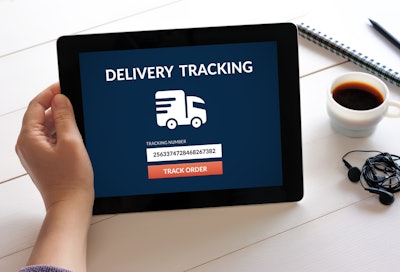 Supply chain professionals are carrying their experiences with business-to-consumer (B2C) e-commerce sites, like Amazon, over to their work lives.
Supply chain professionals are carrying their experiences with business-to-consumer (B2C) e-commerce sites, like Amazon, over to their work lives.About three years ago, Cargill Transportation Logistics (CTL) began to use a predictive supply chain visibility platform from FourKites. CTL manages about 15,000 shipments a week across North America for Cargill, a Wayzata, Minn.-based global agriculture and food manufacturer.
CTL expects transportation providers to comply with visibility requirements by sending shipment tracking updates to FourKites every 15 minutes. Smaller and less able carriers in its network are expected to send updates every two hours at minimum, said Jackie Bailey, regional lead for CTL-North America.
As an asset and non-asset transportation provider, Covenant Transport Services is being asked by shipper customers to meet new visibility requirements.
Covenant’s fleet of more than 3,000 power units is equipped with devices from Omnitracs that update location every 15 minutes. The tracking data is predominately sent to customers today as an EDI 214 transaction set. The requests coming from shippers to provide data for their visibility platforms requires the company to use APIs, Rogers said.
Werner Enterprises, which also has motor carrier and logistics operations, uses EDI to communicate with a number customers electronically, but Andy Damkroger, associate vice president of logistics strategy, said the trend is moving quickly toward APIs that provide richer and more accurate data as well as more functionality.
“I believe that EDI has a place, but we are making active investments in alternatives,” he said. “I think what is possible in terms of technologies and how we can work differently with shippers and carriers is pretty well understood.”
Closing the gap
Meeting customer requirements for freight visibility has not been seamless for 3PLs and carriers, with some using mobile phone apps to comply and others sending tracking data through ELD systems.
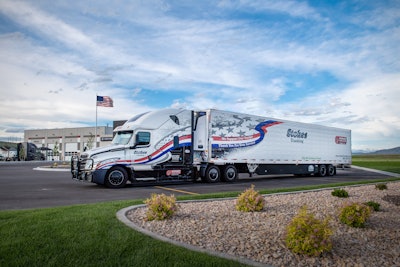 Complying with the new visibility requirements has become easier for Stokes Trucking, a 35-truck refrigerated carrier, since it began using an ELD system from Samsara.
Complying with the new visibility requirements has become easier for Stokes Trucking, a 35-truck refrigerated carrier, since it began using an ELD system from Samsara.Because ELD systems are mandated by law, shippers may unrealistically expect that every truck that a 3PL uses is trackable, but “that is not reality,” said Brandon Arnold, vice president of Intelligent Logistics, an Austin, Texas-based 3PL.
Most carriers that work with Intelligent Logistics have good tracking capabilities and are “open and willing to work with you on it,” he said. Some are unwilling to share tracking data, however, which necessitates the company manually updating tracking information for customers.
Arnold is concerned that 3PLs have “overpromised to their customers something that technically they don’t have any ability to control,” he said. “Carriers have never agreed to this. It has been forced onto them.”
Complying with the new visibility requirements has gotten easier for Stokes Trucking, a 35-truck refrigerated carrier based in Tremonton, Utah, since it began using an ELD system from Samsara.
The company no longer gets manual “check calls” from 3PLs or requests for drivers to download apps on their personal devices.
“The big problem with that was a lot of drivers did not want to download the app or know how. Or, if they could do that, they didn’t care to have their phone tracked. They thought it was an invasion of privacy,” said Tyler Howell, safety administrator at Stokes Trucking.
Some 3PLs withhold a portion of freight payment to carriers whose drivers refuse to download an app that provides shipment tracking information, he said.
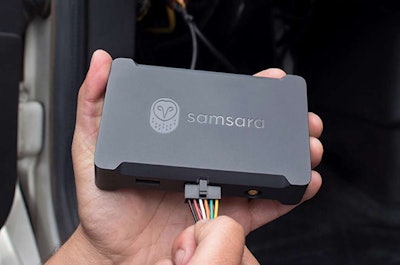 To share tracking information, dispatchers at Stokes Trucking simply provide 3PL customers with the tractor or trailer number its assigns to their loads.
To share tracking information, dispatchers at Stokes Trucking simply provide 3PL customers with the tractor or trailer number its assigns to their loads.To share tracking information, dispatchers at Stokes Trucking simply provide 3PL customers with the tractor or trailer number it assigns to their loads. The 3PLs enter the numbers into their freight visibility platforms and tracking data is automatically exchanged through an API for the duration of each load.
Samsara, like other ELD providers, has an API integration with the major freight visibility platforms to automatically exchange tracking information. Even so, lack of common data standards can hamper the ability of supply chain partners to exchange visibility data.
As an example, a 3PL may request permission from a carrier to get tracking data. The dispatcher might say “truck 38” is assigned to the load. This identifier has to be the exact same format as what the ELD provider uses. If it is different, such as “a38” or “trk38,” the API will not work, explained Covenant’s Ryan Rogers.
Motor carriers could do a better job of providing 3PLs and shippers with the correct information for freight visibility, he said, adding as it stands, the technology is “not an easy plug-and-play.”
Business connectivity
Beyond meeting shippers’ expectations for freight visibility, 3PLs and carriers may also be required to utilize various connectivity tools to conduct no-touch freight transactions.
 Even small and mid-size shippers expect transportation providers to have a self-service web portal they can use to track shipments and do other routine transactions.
Even small and mid-size shippers expect transportation providers to have a self-service web portal they can use to track shipments and do other routine transactions.Cargill’s preferred methods for connecting with 3PLs and carriers is with APIs and EDI. The less sophisticated transportation providers in its network have the option to use web portals that directly interface with its transportation software (TMS) systems to accept load tenders and upload invoices.
Cargill scores transportation providers on how well they use the connectivity tools and comply with tracking requirements, as well as invoice accuracy. During the past 12 months, “we’ve added a lot more importance” to how the providers are performing in these areas, Bailey said.
Heatcraft Worldwide, a manufacturer of commercial refrigeration units, expects the motor carriers and 3PLs it does business with to have a suite of web-based connectivity tools, explained Alicia Whiteside, transportation analyst for the Stone Mountain, Georgia-based company.
In order for Whiteside to respond quickly to customer questions about shipments, she uses the web portals of transportation providers to track shipments and retrieve proof-of-delivery and other load documents.
She expects to know where a shipment is at any given moment, along with getting historical details like when it was loaded, when it arrived at a carrier’s terminal and so forth. If a carrier or 3PL cannot provide shipment tracking details, Whiteside expects to at least know the estimated time of arrival for loads.
Pricing transparency
In addition to meeting expectations for shipment visibility, 3PLs and motor carriers face increased competition to provide immediate pricing and “book it now” options to their customers.
The transportation industry is known for being fragmented, but new sources of data and connectivity tools make it possible for shippers to access real-time and future pricing data.
“We are seeing significant changes in the marketplace,” said CTL’s Jackie Bailey. “What is really driving it is greater access to information.”
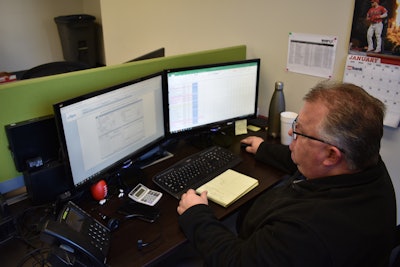 A sales manager for ShipEx Logistics in Salt Lake City reviews lane pricing data from DAT and Truckstop.com
A sales manager for ShipEx Logistics in Salt Lake City reviews lane pricing data from DAT and Truckstop.comAs a shipper, CTL uses data services to track rate movements in the spot and contract freight markets. The additional sources of pricing that are available today give “real-time information on what is happening in the market. This helps us develop our point of view and outlook on the trends in the marketplace,” she added.
“We are much more strategic about contracting for a certain type of freight, and actively procuring some of our capacity through the spot market,” she said. “We can make much more deliberate choices. We continue to look for different tools to automate that.”
Increasingly, transportation companies are investing in robotic process automation (RPA) tools to get all of their systems to communicate in order to share pricing and other data with their customers in real time, said Trey Griggs, global director of sales for Hubtek.
Hubtek provides an RPA platform and staffing augmentation services for logistics companies. Its RPA technology bypasses traditional forms of business connections for systems to talk and to make back-office workflows more efficient, Griggs explained.
“The ability to quote has changed dramatically,” agreed Mike Regan, co-founder of TranzAct Technologies, a logistics information technology company. TranzAct provides managed services to shippers from 3PL, freight audit and payment to reporting, TMS applications and carrier rate negotiations.
In addition to having transparent pricing data, 3PLs are using new connectivity tools that make capacity procurement faster and more efficient. “Right now, I think the main thing you are having to do to be successful is to take cost out,” he said.
The value of relationships
In the final analysis, the value of personal relationships has not diminished, even though new technologies continue to enter the supply chain.
3PLs are not always successful in getting small carriers and drivers to share tracking information, at least not without putting in the work. To overcome the hurdles of rolling out new technology, “you have to build relationships,” said Intelligent Logistics’ Brandon Arnold.
Many shipments that RLS Logistics transports with independent contractors are difficult to track, said Russell Leo, CEO of the Newfield, New Jersey-based company. RLS Logistics uses smartphone apps from Descartes Macropoint and Trucker Tools, but Leo estimates that 40% of independents still do not want to be tracked.
RLS Logistics, which specializes in warehousing and transporting frozen and refrigerated food products, uses a soft approach. Its dispatchers explain to carriers that without load tracking technology they cannot capture and compensate for detention.
“We are seeing a greater acceptance rate because of that,” he said.
Another benefit for carriers that use tracking apps from RLS Logistics is they can capture and send electronic PODs to get paid faster, he explained. “It helps everyone, though unfortunately with some small carriers you have got to explain the benefits they will receive if they start embracing different technology apps,” he said.
3PLs also need relationships with carriers to get proactive communications about their drivers’ hours of service availability and other essential information, Leo said.
“The more complex the freight, the more interaction will still be required from person-to-person to get the job done,” he continued. “At end of day, being able to talk to the driver through the phone, text, or email will never go away.”
Werner Enterprises’ Andy Damkroger agreed. “Relationships still matter,” he said, and the technology that 3PLs use should enhance relationships with carriers by giving them different options depending on their size, scale and sophistication, to stay connected.
“It all comes down to preference and capability,” he said.




